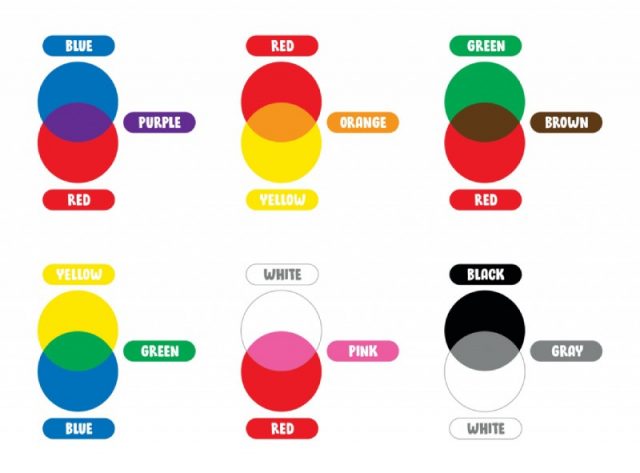The colors red and green are diametrically opposed to one another; red is a primary colour, and green is a secondary color. They combine well to produce a completely different color. There are various accounts of the final colour that red and green produce; as a result, you must analyse the situation in order to determine what colour to expect to be produced. The other primary colours are yellow and blue, while the secondary colours are orange, green, and violet. Apart from red, the other primary colours are yellow and blue. Colours in the tertiary range include the shades of red and orange as well as yellow and green. They are also represented by the hues of blue, green, blue violet and red. In colour theory, tertiary colours are those that result from the combination of primary and secondary colours.
Table of Contents
What Colour Do Red and Green Make?
Essentially, there are two types of colour mixing methods: additive and subtractive colour mixing. Depending on the method you employ, you may obtain a colour that differs from what you had originally anticipated.
Read More: How Many Cups Are In 250 Grams
Additive Mixing
When it comes to colour mixing, additive mixing is not the method that we are used to thinking about. Although it is a fairly common method in today’s technology-driven society, it is one that we see almost on a daily basis without even realizing it.
When mixing colours with additive mixing, you use a variety of different spectral light combinations. This method is frequently used in the media and is most commonly used to produce the colours that appear on television screens and computer monitors.
Colors can be combined in two ways using additive mixing: first, they can be mixed together in a rainbow fashion, and second, they can be mixed together in a geometric pattern.
- The electron guns in television and computer monitors use two colours and fire two different colours at the same time, causing our eyes to see them as they morph together into a completely different colour as a result of the rapid firing of two different colours.
- It is possible to combine two or more solid spectral coloured lights by placing them close together, which causes our eyes to optically mix the two colours together to produce a different colour.
What You Should Know About Color Schemes Or Harmony
Increase or decrease the intensity of an individual component colour or the final results are two ways to achieve colour harmony between them. In order to darken the colour, for example, one must first create a shade of the original colour. In most cases, you can reduce the intensity of the colour by adding a small amount of dark to the mix.
Another method of darkening a colour is to incorporate a complementary colour, which is the colour that is opposite it on the colour wheel. This will result in a more vibrant colour than simply adding black. Blue and orange, green and red, black and white, and yellow and purple are some of the most prominent complementary colours you can use to create harmony in your home.
It is the brightness or dullness of a color’s intensity that determines whether it is bright red or dull red; for example, a bright red or dull red indicates the intensity of the colour.
Read More: How To Get A UMID Card PIN Code
The Harmony Of Monochrome
Monochrome, which refers to a single colour, is a type of harmony in which one colour is represented by a variety of values (value is the lightness or darkness of a color). Any colour combination that contains white, black, or grey is an excellent example of a monochrome colour scheme or harmony.
Colors That Are Adjacent To One Another
This is also referred to as analogous colour, and it is created by mixing colours that are adjacent to each other on the colour wheel. Colors like reds and oranges, for example, are adjacent colours that can be used to create different colour harmonies.
Single Split Complement Color (Single Split Complement)
Colors on either side of the complement are represented by primaries in this scheme. A good example is the different intensities of greens, violet-reds, and orange-reds that can be found in nature.A Triad is a group of three people.
Using colours at different points on the equilateral triangle, you can create a colour harmony. This is a combination of three colours that are evenly spaced on the colour wheel. They are frequently referred to as “balanced” colours because of their harmony. The colours red, blue, and yellow, as well as white and black greys, are
examples of a triad colour scheme.
Read More: How To Know Your CRN In SSS
RGB Color Wheel
When it comes to colour mixing in light or on a screen, this method makes use of the RGB colour wheel. The primary colours of light used on the wheel are represented by the colours red, blue, and green in this representation. The secondary colours are created by combining two primary colours, yielding cyan, magenta, and yellow as a result of the reaction.
When red and green are combined, the colour yellow is produced, which is consistent with their positions on the RGB colour wheel.
The RGB colour wheel, which is used for creating colours using light spectrums, is nearly the polar opposite of the CMYK colour wheel, which has traditionally been used for mixing colours in art and print processing, a process known as subtractive mixing.
CMYK Color Wheel
In contrast to the RGB colour wheel, which is used for combining colours across the entire light spectrum, the CMYK colour wheel has three primary colours: cyan, magenta, and yellow. These colours are frequently used in art production because they correspond to the traditional primary colours of the art colour wheel (blue, red, and yellow).
On the RGB colour wheel, the secondary colours, on the other hand, are the same as the primary colours (red, blue and green).
Color combinations are created in print processing by layering the primary CMY colours with varying percentages of transparency on top of one another in various configurations. As soon as the colours are overlapped, light is transmitted through the ink and reflected off of the surface beneath the ink, which is referred to as the substrate.
To achieve the intended colour, the CMY ink is applied as halftone dots, which subtract the inverse percentages of RBG from the reflected light to produce the desired colour perception.
When It Comes To Colour Mixing, There Are Several Methods to Choose From.
In terms of colour mixing options, there are two types to choose from: additive and subtractive colour mixing techniques.
The Additive Color Mixing Process A.
The additive colour mixing method differs from the traditional colour mixing method that we use on a daily basis. The modern system of colour mixing has become a standard method of colour mixing that we see on a daily basis without even realising it.
When mixing different colours, you can use a variety of spectral light combinations to achieve a more complex result. For example, the additive colour mixing method is widely used in the media and is the method by which colours are projected on computer and television screens is fairly standard.
When it comes to additive mixing, there are two methods by which colours can be mixed: the use of two colours and the use of two or more spectral colour lights. The use of two or more spectral colour lights is the most common method.
The additive combination of two colours is achieved by firing two different colours at the same time. Your eyes will see these colours mixed together to form a completely new colour as a result of this process. In the other type of additive colour mixing, two or more lights are combined by placing them close to each other, causing your naked eyes to perceive them as different colours as a result of the mixing.
Color Subtractive Mixing (Also Known As Subtractive Colour Mixing)
The subtractive method of colour mixing is a more intuitive process that is associated with the traditional method of colour mixing. It is also less expensive. When pigments within a specific object absorb white light and then reflect other pigments contained within the colour, this is referred to as the subtractive method of mixing colours.
For example, the colour red reflects all of the wavelengths of white light except for the wavelengths emitted by the red pigment. Using this straightforward explanation, we can understand why some colours are reflected outwards and others are not.
Follow Techadvices for the Best of the Technology.






